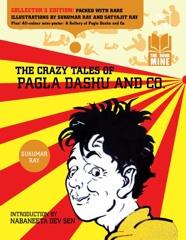

Reviewing books can be quite a daunting task, and it doesn’t help matters when you find out that the author you’re reviewing was born a whole century before you!
Pagla Dashu is a collection of 25 Bangla short stories by children’s writer Sukumar Ray, father of award-winning film-maker Satyajit Ray, that have been translated into English by the Jadavpur University Translators’ Collective.
Sukumar Ray has to his credit many prose and poetry collections, and generations of Bengali children have grown up reading his classics like Abol Tabol and Ha-Ja-Ba-Ra-La. Pagla Dashu was first published in 1940, thirteen years after Ray’s death due to kala-azar.
The main protagonist of the book is the eponymous ‘pagla’ (mad) Dashu, who, as the narrator often reminds us, is more carefree than crazy. Dasharathi is a free spirit, and often gets away with pranks on uptight or boastful characters with nothing more severe than a boxed ear.
Mischief is timeless and isn’t limited by language. Years after these stories were written, it’s still fun to read about the antics of Dashu’s friends and adversaries. Ray’s vivid descriptions of the way his characters dress and conduct themselves will help kids get a glimpse of school life in a different era.
Since most of the stories are set in and around school, there are plenty of pranks pulled on teachers and headmasters – the favourite adversaries of school children across the world. In addition to these, there is a whole range of madcap guest characters in the stories, illustrated wonderfully by both Sukumar and Satyajit Ray.
The stories include a smattering of Bengali words, which would be understandable even to those unfamiliar with the language. Though each story has been translated by a different member of the university’s translation team, the book has the same consistent style and tone throughout.
The only disconcerting aspect of the book would be the lack of female characters in the stories. This may have something to do with the time period and social setting the stories were written in. The school setup chosen for the stories also seems provincial, which might explain why there’s hardly any mention of schoolgirls.
Most of the stories do not run beyond three to four pages, making them fun for kids to read at bedtime or in short bursts. The stories are episodic, so kids can stop and resume reading the book from wherever they want without getting bored.
The book also contains a delightfully absurd diary account of explorer Heshoram Hunshiyar and the fantasy creatures he meets in the course of his work. Pagla Dashu ends with an account of Ray’s life and influences, a palatable dose of history for kids.